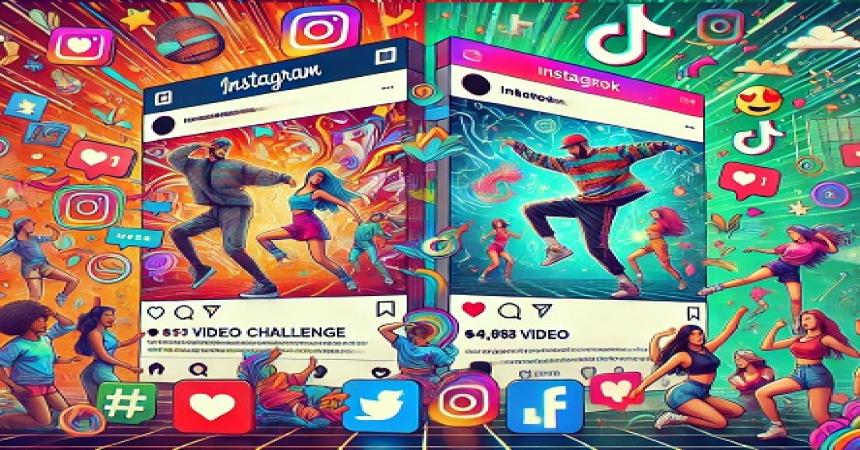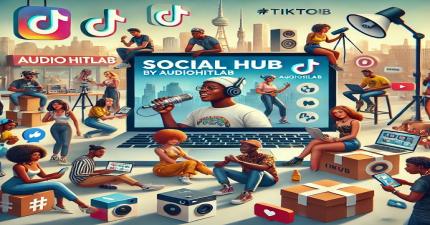
- 28 Sep, 2024
TikTok Video Challenges: A Deep Dive into the Phenomenon
TikTok, the short-form video platform launched in 2016 by the Chinese tech company ByteDance, has become a dominant force in the social media landscape, influencing everything from entertainment to marketing, politics, and pop culture. A major driver of its success is the viral nature of its video challenges. These challenges, which encourage users to participate in a specific task or theme, have played a pivotal role in the platform's explosive growth and cultural relevance. In this essay, we will explore the phenomenon of TikTok video challenges, their impact on users, the evolution of trends, and the societal implications they hold.
1. The Rise of TikTok and the Birth of Challenges
When TikTok first launched, it was initially targeted at a younger demographic, offering them a platform for creating and sharing short videos set to music. Over time, the app's algorithm, which recommends content based on user interactions, enabled videos to go viral quickly, even if the creator had a small following. This democratization of virality laid the foundation for the success of video challenges.
TikTok challenges typically involve a specific task, dance move, or theme that users are encouraged to replicate and share with their followers. Some challenges are initiated by influencers or celebrities, while others are started by ordinary users who create content that catches on quickly. The use of hashtags, which group similar videos together, makes it easy for users to find and participate in challenges. Hashtags like #RenegadeChallenge, #SavageChallenge, and #FlipTheSwitch are just a few examples of viral challenges that have swept through TikTok, sparking mass participation.
2. The Mechanics of a TikTok Challenge
A TikTok challenge is often simple in concept, but it can vary widely in execution. Here are some key elements that typically define a successful challenge:
a) A Clear Action or Theme
At the core of a TikTok challenge is a specific action or theme that is easy to replicate. This could be a particular dance move, a comedy sketch, a lip-sync performance, or even a viral meme. For example, the #RenegadeChallenge, which involved a highly choreographed dance to the song "Lottery" by K CAMP, became wildly popular because the dance was catchy and easy to learn, and the song's beat resonated with TikTok’s younger audience.
b) Accessibility and Simplicity
Challenges that are easy to participate in and require little more than a smartphone and a basic understanding of TikTok’s tools are more likely to go viral. These challenges usually rely on accessibility, allowing anyone to try them out regardless of their skill level or resources. A challenge may involve simple steps or relatable actions that don’t require specialized equipment or extensive practice. For example, a lip-sync challenge or a challenge involving a basic reaction video can be done by nearly anyone.
c) Viral Elements
To succeed, TikTok challenges must have a viral component. This could be an element of surprise, humor, or relatability. Many challenges use trending sounds or songs, which increases the likelihood that a video will be recommended by TikTok's algorithm. Participating in a challenge taps into a larger cultural moment, so videos tied to the latest trends or memes often get more views.
d) User Engagement and Participation
The most successful challenges encourage user engagement, either by asking people to join in or share their own versions of the challenge. The best challenges create a sense of community, with participants encouraging each other and often providing creative twists on the original idea. This community-driven aspect is part of what makes TikTok challenges so powerful and ubiquitous.
3. The Cultural Impact of TikTok Challenges
TikTok challenges have had a far-reaching cultural impact, shaping entertainment, social interactions, and even consumer behavior. Some of the most notable impacts include:
a) Shaping Music and Dance Culture
One of the most significant ways that TikTok challenges have affected culture is through music and dance. Songs that become associated with viral challenges often experience a surge in popularity. For example, "Old Town Road" by Lil Nas X gained widespread attention after it became the soundtrack for a viral TikTok challenge. Similarly, the #SavageChallenge and the #RenegadeChallenge propelled certain songs to the top of the charts.
Dance moves, many of which are choreographed by TikTok users themselves, have also become a prominent part of the platform’s culture. Dance challenges, particularly those set to catchy songs, have become a hallmark of TikTok. This has led to a democratization of dance, where young people from all over the world can contribute their creativity and, in some cases, gain fame. The success of the #RenegadeDance, for example, catapulted creator Jalaiah Harmon into the spotlight, highlighting how TikTok’s viral challenges can transform the lives of ordinary users.
b) Creating Digital Communities
TikTok challenges also foster a sense of belonging and community. For example, challenges tied to certain subcultures, identities, or causes allow people to share common experiences. Some challenges have centered on social issues like mental health awareness, racial justice, or LGBTQ+ pride, creating an avenue for people to express solidarity and raise awareness. Challenges like #BlackLivesMatter and #PrideChallenge serve as digital spaces for individuals to unite around important issues, while still participating in the playful, trend-driven nature of TikTok.
c) Memes and Viral Content
Memes are a central aspect of TikTok culture, and many challenges are born out of meme-worthy moments. These challenges often take viral videos or trends and encourage users to recreate or riff on them. TikTok users have created and remixed challenges based on popular internet memes, often resulting in humorous or unexpected twists. This has blurred the line between traditional internet memes and social media trends, creating a unique space where viral content and challenges intersect.
d) Influencing Popular Culture
The viral nature of TikTok challenges has given rise to a new wave of influencers, many of whom gain recognition through their participation in or creation of challenges. TikTok stars like Charli D’Amelio and Addison Rae, for instance, became well-known largely due to their dance videos, which were often tied to specific challenges. TikTok has thus transformed the way influencers and celebrities interact with their audiences, with the challenge format offering a new avenue for building fame and engagement.
4. The Business of TikTok Challenges
TikTok challenges have not only impacted culture but have also become a powerful marketing tool. Brands have recognized the potential of viral challenges to engage consumers and promote products in innovative ways. Brands often collaborate with influencers or create their own challenges to encourage user participation. For example, cosmetics brands like Maybelline and skincare companies have launched product-based challenges that encourage users to showcase their creativity while promoting their products.
Additionally, TikTok’s algorithm makes it relatively easy for brands to gain visibility on the platform. Challenges that incorporate branded hashtags or that are tied to popular trends often receive high levels of engagement, making them an effective strategy for businesses looking to reach younger demographics. For example, the #InMyDenim challenge by Guess allowed users to share their own outfit transformations, while also promoting Guess products. Similarly, the #ChipotleLidFlip challenge encouraged users to create videos where they "flip" the lid of a Chipotle bowl, earning a special prize in return for participation.
These branded challenges tap into the same principles that make TikTok challenges so successful—engagement, creativity, and virality. The ability to combine user-generated content with marketing goals has made TikTok a key player in the influencer and digital marketing industries.
5. The Dark Side of TikTok Challenges
While TikTok challenges can be a force for creativity, fun, and engagement, there are also darker sides to this phenomenon. Some challenges, particularly those that encourage risky or dangerous behavior, have raised concerns. For instance, the #SkullBreakerChallenge, which involved tripping someone while they were jumping in the air, resulted in several injuries and even fatalities. These challenges have led to calls for increased moderation on the platform to ensure that content is safe for all users, especially younger audiences.
Moreover, there is the issue of challenge fatigue. The constant stream of viral challenges can make it difficult for users to keep up, leading to feelings of pressure or inadequacy. Some users might feel the need to participate in every challenge to maintain relevance or gain visibility, contributing to a culture of comparison and competition.
Finally, the algorithm-driven nature of TikTok can sometimes amplify content that is designed purely for shock value, leading to the spread of misinformation or harmful trends. This is something that TikTok has been working to address through various measures, such as stricter content moderation policies and fact-checking initiatives, but challenges that promote divisiveness or misinformation can still sometimes gain traction.
6. Conclusion
TikTok video challenges have become one of the most defining aspects of the platform, influencing everything from entertainment to marketing, culture, and even politics. These challenges tap into the human desire for creativity, community, and participation, creating viral trends that can have a far-reaching impact. While they have certainly provided a platform for self-expression, they also come with certain risks and challenges, including dangerous trends and the pressure to constantly participate in every viral movement.
Ultimately, TikTok video challenges have redefined how we interact with social media, turning passive consumption into active participation. As the platform continues to evolve, it will be fascinating to see how these challenges continue to shape the digital landscape and influence the cultural zeitgeist. Whether they are used for fun, education, activism, or marketing, TikTok challenges are here to stay as a defining feature of the app and the broader social media environment.


